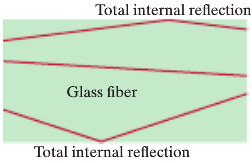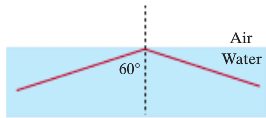Light Refraction: Bending of light
By: Elisa Mercando
The Main Idea
Light refraction is the wavelengths of light entering different materials, where the speed is different. The refraction of light when it passes through a fast medium to a slow medium causing the light ray to bend between the two mediums.
The wavelength, [math]\displaystyle{ \gamma }[/math], of the radiation can either be shorter or longer (depending on the material). The frequency and period of the oscillation do not change, so the speed of the ray changes ([math]\displaystyle{ speed = \frac{\gamma}{T} }[/math]).

A Mathematical Model
The refraction of light can be explained by Snell's law. Snell's law describes a relationship between the bending of the light rays at the medium and speed of the ray in the two medium.

The rays can be represented as straight lines, and the direction of the incoming and outgoing rays can be expressed as angles between the ray and the normal vector (perpendicular to the surface). We can assign [math]\displaystyle{ \theta_1 }[/math] for the incoming angle of the ray and [math]\displaystyle{ \theta_2 }[/math] for the outgoing angle of the ray. The speed of the ray in the air is [math]\displaystyle{ v_1 }[/math] and the speed in the material is [math]\displaystyle{ v_2 }[/math]. In the time T, the ray travels [math]\displaystyle{ v_1*T }[/math] in the air and [math]\displaystyle{ v_2*T }[/math] in the material. The two triangles formed by the angles share a side, d.
The incoming angle is expressed as [math]\displaystyle{ \sin(\theta_1) = \frac{v_1*T}{d} }[/math] and the outgoing angle is expressed as [math]\displaystyle{ \sin(\theta_2) = \frac{v_2*T}{d} }[/math]. [math]\displaystyle{ \frac{T}{d} }[/math] is the same for both triangles. So, [math]\displaystyle{ \frac{\sin(\theta_1}{v_1} = \frac{\sin(\theta_2}{v_2} }[/math].
The index of refraction is expressed as [math]\displaystyle{ n = c/v }[/math].
Therefore, [math]\displaystyle{ \frac{\sin(\theta_1}{c/n_1} = \frac{\sin(\theta_2}{c/n_2} }[/math]. Then we cancel the common factor, c.
Snell's Law: [math]\displaystyle{ n_1\sin(\theta_1) = n_2\sin(\theta_2) }[/math]
A Computational Model
How do we visualize or predict using this topic. Consider embedding some vpython code here Teach hands-on with GlowScript
Examples
Ray Travels from Water into Glass
A beam of light travels through water and hits a glass surface. The angle [math]\displaystyle{ \theta_1 }[/math] between the incident beam and the normal to the glass surface is 23 degrees. The index of refraction of water is 1.33 and the index of refraction of this type of glass is 1.65. What is the angle [math]\displaystyle{ \theta_2 }[/math]?

Solution:
[math]\displaystyle{ n_1\sin(\theta_1) = n_2\sin(\theta_2) }[/math]
[math]\displaystyle{ \sin(\theta_2) = \frac{n_1\sin(\theta_1}{n_2} }[/math]
[math]\displaystyle{ \theta_2 = arcsin\frac{1.33*\sin(23)}{1.65} = }[/math]18.4 degrees
Total Internal Reflection
We've only discussed light that passes from air to glass causing a decrease in the speed of the ray associated with an increase in the index of refraction.
But what happens if we go in the other direction? Going from a higher index of refraction to a lower index of refraction?
Suppose light goes from water (refraction index=1.33) into air (refraction index=1.0). Consider a ray in water at an angle of 60 degrees to the normal. Now predict the angle the ray will make to the normal in the air.
[math]\displaystyle{ 1.33*\sin(60) = 1.0*\sin(\theta_2) }[/math]
[math]\displaystyle{ \sin(\theta_2) = 1.33*\sin(60) = }[/math] 1.15
BUT...if we take arcsin of 1.15 we get an ERROR, because 1.15 is out of range of the sin function.
This means that there is no possible angle for this ray to make in the air. What if the ray is at an angle of 60 degrees to the vertical tries to emerge from the pool of water into the air above?
It doesn't emerge, but it reflects back down into the water! this is called total internal reflection.
Let's try to find the angle to the vertical for a ray in the water that gives a ray in the air at 90 degrees to the vertical. (Because 90 degrees is the largest possible angle from the vertical that is normal to the surface)
[math]\displaystyle{ 1.33*\sin(\theta_1) = 1.0*\sin(90) }[/math]
[math]\displaystyle{ \sin(\theta_1) = \frac{1.0}{1.33} = }[/math]0.75
[math]\displaystyle{ \theta_1 = }[/math] 49 degrees
Any underwater rays at more than 49 degrees to the vertical cannot escape into the air, but are internally reflected back into the water.

Connectedness
How is this topic connected to something that you are interested in? This topic of light refraction is important in fiber optics. Fiber optics is used in long-distance high-speed internet connections. Fiber optics is very interesting to me, because we use the internet for just about everything now! We can transmit more data over long distances by means of light propagating in glass fibers rather than by electrical signals propagating through copper wires. The glass fibers must be able to allow light rays to travel through it by undergoing total internal reflection at the surface rather than escaping. This means there needs to be an appropriate index of refraction.

How is it connected to your major? And is there an industrial application of it? My major is biology/pre-med and the refraction of light is very important in refractive surgery, otherwise known as LASIK. Refractive surgery is the removal of the corneal tissue with a special laser that reshapes the cornea. The cornea is the part of the eye that helps focus light to create an image on the retina that is sent through the optic nerve to be interpreted by the brain. The bending and focusing of light in the eye is known as refraction, hence the name of the surgery, refractive surgery, that help reshape the cornea to allow the eye to focus.
History
Ptolemy first tried to come up with the law of refraction through an experiment, where he measured the angle of a ray of light as it enters a boundary, and the angle at which it leaves through different mediums. But he could never determine the full equation.
In 984 AD, Ibn Sahl discovered the law of refraction [math]\displaystyle{ \frac{\sin(\theta_1)}{\sin(\theta_2)} = \frac{v_1}{v_2} = \frac{n_1}{n_2} }[/math]. Sahl was a mathematician from Baghdad that finished the work that Ptolemy had been working on. The experiment he conducted that helped him derive Snell's Law, was using a laser and shining it into a pool of water. In order to arrive at that equation, he used the law of sines to relate the angle of the ray to the normal vector.

See also
The refraction of light is an interesting topic. But refraction doesn't just apply to light. Refraction can also be applied to sound. Which you can learn more about in the link below! There is also an animation in the link below that one that illustrates how objects in different materials look compared to how they look in air.
Further reading
http://hyperphysics.phy-astr.gsu.edu/hbase/geoopt/refr.html
http://interactagram.com/physics/optics/refraction/
External links
http://science.larouchepac.com/fermat/history.html
http://www.historyofinformation.com/expanded.php?id=2413
http://www.physicsclassroom.com/class/refrn/Lesson-1/The-Cause-of-Refraction
References
http://www.thestargarden.co.uk/RefractionReflectionDiffraction.html
Matter & Interactions, Vol. II: Electric and Magnetic Interactions, 4nd Edition by R. Chabay & B. Sherwood (John Wiley & Sons 2015)

